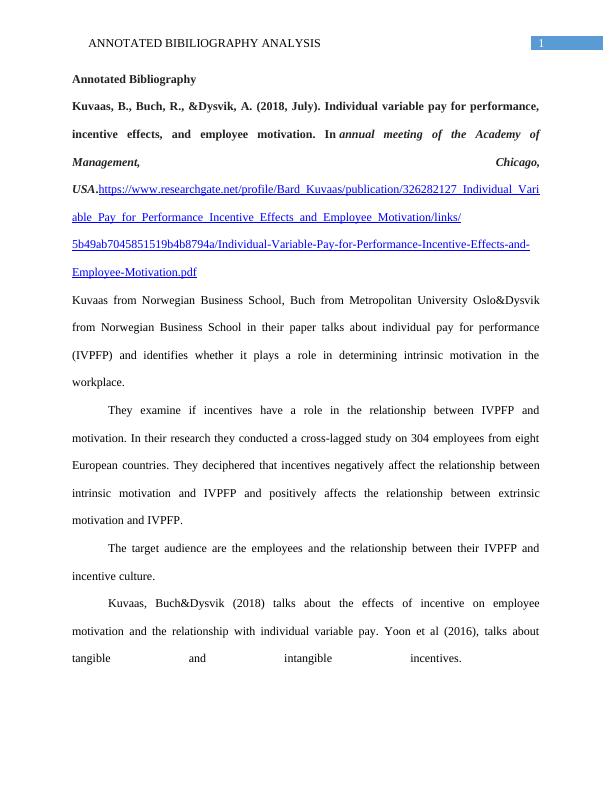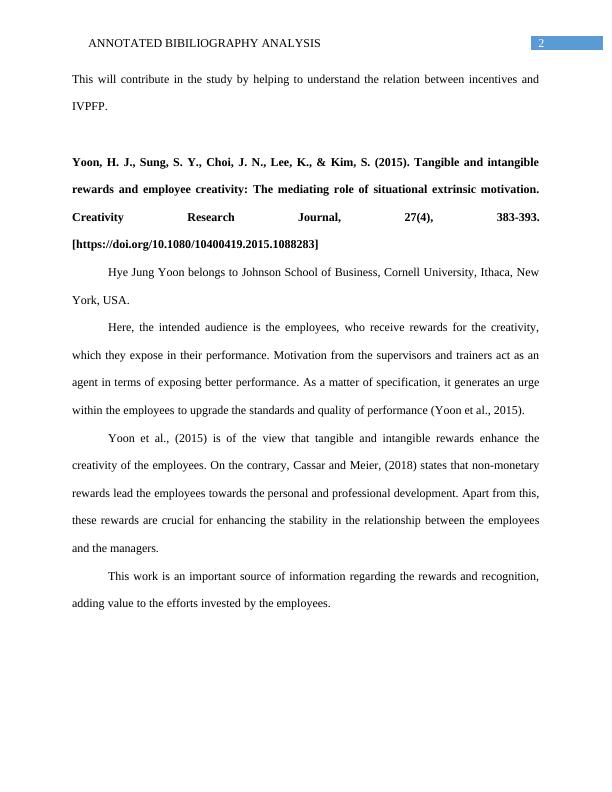Annotated Bibliography Analysis Assignment 2022
Added on 2022-09-30
11 Pages2518 Words38 Views
Running head: ANNOTATED BIBILIOGRAPHY ANALYSIS
Annotated Bibliography Analysis
Name of Student
Name of University
Author Note
Annotated Bibliography Analysis
Name of Student
Name of University
Author Note

1ANNOTATED BIBILIOGRAPHY ANALYSIS
Annotated Bibliography
Kuvaas, B., Buch, R., &Dysvik, A. (2018, July). Individual variable pay for performance,
incentive effects, and employee motivation. In annual meeting of the Academy of
Management, Chicago,
USA.https://www.researchgate.net/profile/Bard_Kuvaas/publication/326282127_Individual_Vari
able_Pay_for_Performance_Incentive_Effects_and_Employee_Motivation/links/
5b49ab7045851519b4b8794a/Individual-Variable-Pay-for-Performance-Incentive-Effects-and-
Employee-Motivation.pdf
Kuvaas from Norwegian Business School, Buch from Metropolitan University Oslo&Dysvik
from Norwegian Business School in their paper talks about individual pay for performance
(IVPFP) and identifies whether it plays a role in determining intrinsic motivation in the
workplace.
They examine if incentives have a role in the relationship between IVPFP and
motivation. In their research they conducted a cross-lagged study on 304 employees from eight
European countries. They deciphered that incentives negatively affect the relationship between
intrinsic motivation and IVPFP and positively affects the relationship between extrinsic
motivation and IVPFP.
The target audience are the employees and the relationship between their IVPFP and
incentive culture.
Kuvaas, Buch&Dysvik (2018) talks about the effects of incentive on employee
motivation and the relationship with individual variable pay. Yoon et al (2016), talks about
tangible and intangible incentives.
Annotated Bibliography
Kuvaas, B., Buch, R., &Dysvik, A. (2018, July). Individual variable pay for performance,
incentive effects, and employee motivation. In annual meeting of the Academy of
Management, Chicago,
USA.https://www.researchgate.net/profile/Bard_Kuvaas/publication/326282127_Individual_Vari
able_Pay_for_Performance_Incentive_Effects_and_Employee_Motivation/links/
5b49ab7045851519b4b8794a/Individual-Variable-Pay-for-Performance-Incentive-Effects-and-
Employee-Motivation.pdf
Kuvaas from Norwegian Business School, Buch from Metropolitan University Oslo&Dysvik
from Norwegian Business School in their paper talks about individual pay for performance
(IVPFP) and identifies whether it plays a role in determining intrinsic motivation in the
workplace.
They examine if incentives have a role in the relationship between IVPFP and
motivation. In their research they conducted a cross-lagged study on 304 employees from eight
European countries. They deciphered that incentives negatively affect the relationship between
intrinsic motivation and IVPFP and positively affects the relationship between extrinsic
motivation and IVPFP.
The target audience are the employees and the relationship between their IVPFP and
incentive culture.
Kuvaas, Buch&Dysvik (2018) talks about the effects of incentive on employee
motivation and the relationship with individual variable pay. Yoon et al (2016), talks about
tangible and intangible incentives.

2ANNOTATED BIBILIOGRAPHY ANALYSIS
This will contribute in the study by helping to understand the relation between incentives and
IVPFP.
Yoon, H. J., Sung, S. Y., Choi, J. N., Lee, K., & Kim, S. (2015). Tangible and intangible
rewards and employee creativity: The mediating role of situational extrinsic motivation.
Creativity Research Journal, 27(4), 383-393.
[https://doi.org/10.1080/10400419.2015.1088283]
Hye Jung Yoon belongs to Johnson School of Business, Cornell University, Ithaca, New
York, USA.
Here, the intended audience is the employees, who receive rewards for the creativity,
which they expose in their performance. Motivation from the supervisors and trainers act as an
agent in terms of exposing better performance. As a matter of specification, it generates an urge
within the employees to upgrade the standards and quality of performance (Yoon et al., 2015).
Yoon et al., (2015) is of the view that tangible and intangible rewards enhance the
creativity of the employees. On the contrary, Cassar and Meier, (2018) states that non-monetary
rewards lead the employees towards the personal and professional development. Apart from this,
these rewards are crucial for enhancing the stability in the relationship between the employees
and the managers.
This work is an important source of information regarding the rewards and recognition,
adding value to the efforts invested by the employees.
This will contribute in the study by helping to understand the relation between incentives and
IVPFP.
Yoon, H. J., Sung, S. Y., Choi, J. N., Lee, K., & Kim, S. (2015). Tangible and intangible
rewards and employee creativity: The mediating role of situational extrinsic motivation.
Creativity Research Journal, 27(4), 383-393.
[https://doi.org/10.1080/10400419.2015.1088283]
Hye Jung Yoon belongs to Johnson School of Business, Cornell University, Ithaca, New
York, USA.
Here, the intended audience is the employees, who receive rewards for the creativity,
which they expose in their performance. Motivation from the supervisors and trainers act as an
agent in terms of exposing better performance. As a matter of specification, it generates an urge
within the employees to upgrade the standards and quality of performance (Yoon et al., 2015).
Yoon et al., (2015) is of the view that tangible and intangible rewards enhance the
creativity of the employees. On the contrary, Cassar and Meier, (2018) states that non-monetary
rewards lead the employees towards the personal and professional development. Apart from this,
these rewards are crucial for enhancing the stability in the relationship between the employees
and the managers.
This work is an important source of information regarding the rewards and recognition,
adding value to the efforts invested by the employees.

3ANNOTATED BIBILIOGRAPHY ANALYSIS
Cassar, L., & Meier, S. (2018). Nonmonetary Incentives and the Implications of Work as a
Source of Meaning. Journal of Economic Perspectives, 32(3), 215-38. [DOI:
10.1257/jep.32.3.215]
Stephen Meier belongs to Columbia Business School, 3022 Broadway New York, NY
10027. Here, the intended audience are the workers, who need non-monetary rewards for
fulfilling the need of job satisfaction (Cassar& Meier, 2018).
Cassar and Meier, (2018) is of the view that non-monetary incentives are a source, which
adds meaning to the employment of the employees. In comparison to this, Howard, Turban and
Hurley, (2016) states that cooperation is the agent through which the businesses can enhance the
productivity. Incentives are the means for luring the employees towards the organizational
requirements.
This article acts as a secondary source of information for the readers in terms of gaining
an insight into the importance for non-monetary rewards. This is in terms of getting job
satisfaction, which adds meaning to their employment (Cassar& Meier, 2018).
Howard, L. W., Turban, D. B., & Hurley, S. K. (2016). Cooperating teams and competing
reward strategies: Incentives for team performance and firm productivity. Journal of
Behavioral and Applied Management, 3(3), 1054.
Larry W. Howard belongs to Middle Tennessee University.
In this context, the intended audience are the teams, working towards enhancing the
productivity of the organizations.
According to the arguments of Howard, Turban and Hurley, (2016), unity and
coordination are the keystone towards enhancing the productivity. Gibbs, Neckermann and
Cassar, L., & Meier, S. (2018). Nonmonetary Incentives and the Implications of Work as a
Source of Meaning. Journal of Economic Perspectives, 32(3), 215-38. [DOI:
10.1257/jep.32.3.215]
Stephen Meier belongs to Columbia Business School, 3022 Broadway New York, NY
10027. Here, the intended audience are the workers, who need non-monetary rewards for
fulfilling the need of job satisfaction (Cassar& Meier, 2018).
Cassar and Meier, (2018) is of the view that non-monetary incentives are a source, which
adds meaning to the employment of the employees. In comparison to this, Howard, Turban and
Hurley, (2016) states that cooperation is the agent through which the businesses can enhance the
productivity. Incentives are the means for luring the employees towards the organizational
requirements.
This article acts as a secondary source of information for the readers in terms of gaining
an insight into the importance for non-monetary rewards. This is in terms of getting job
satisfaction, which adds meaning to their employment (Cassar& Meier, 2018).
Howard, L. W., Turban, D. B., & Hurley, S. K. (2016). Cooperating teams and competing
reward strategies: Incentives for team performance and firm productivity. Journal of
Behavioral and Applied Management, 3(3), 1054.
Larry W. Howard belongs to Middle Tennessee University.
In this context, the intended audience are the teams, working towards enhancing the
productivity of the organizations.
According to the arguments of Howard, Turban and Hurley, (2016), unity and
coordination are the keystone towards enhancing the productivity. Gibbs, Neckermann and

End of preview
Want to access all the pages? Upload your documents or become a member.
Related Documents
Annotated bibliography analysis Research 2022lg...
|3
|594
|26
Motivation in Organizationlg...
|6
|1691
|60
Money and Other Financial Rewards in Employee Motivationlg...
|8
|2308
|56
Human Resources Retention and Selection in Business Groupslg...
|12
|2695
|383
